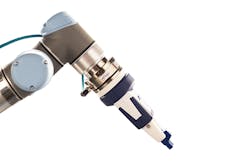Empowering Robots with the Sense of Touch
For manufacturers hoping to survive in today’s digital economy, there is a growing need to embrace opportunities that propel smart manufacturing forward. Adding force and torque sensing capabilities to an automated solution is a prime example.
Force sensing gives the robot a sense of touch in an automated or semi-automated environment. It allows manufacturers to realize new capabilities as well as add value to existing processes by empowering robots with dynamic responsiveness.
“With F/T Sensors, we can monitor forces during a wide variety of processes. If the robot is handling a delicate part or perhaps assembling one part to another, we can guide it to use a precise amount of force to execute the job,” says Ian Stern, Force/Torque Product Manager for ATI Industrial Automation. “While a robot is moving, Force/Torque sensors make it quick and easy to identify any change in process forces. If a part is dropped out of the gripper, the change in force could indicate that something isn’t right.”
Force sensing can also play a crucial role in identifying tooling wear or unplanned changes in fixturing. They provide a level of awareness that keeps the robot, the products, and the end-of-arm-tools safe from mishaps like crashes or improper processing. Force sensing enables new capabilities in material handling such as validation of part count, identifying parts by weight, and optimizing cycle time.
Down to Details
At roughly half the cost of previous sensor systems, ATI’s Axia80 offering provides manufacturers an affordable segue into force/torque sensing. “The Axia series of force/torque sensors provide the same industry-leading performance consistent across ATI’s entire Force/Torque product line, but at a price point that makes it easy to justify the investment,” explains Stern. “After all, if a robot damages a part, a fixture—even one time, the resulting expense to repair or replace it could be far greater than the cost of a force/torque sensor.”
ATI will expand upon the Axia80 sensor with a full line of Axia products. The company developed the Axia130 for higher payload applications and plans to release new versions soon. ATI’s Axia sensors feature onboard electronics that keep their footprint small and reduce costs while maintaining the accuracy, resolution, and robustness inherent in ATI Force/Torque sensors.
Of course, within smart manufacturing environments, the ability to effectively communicate is crucial. One of the key benefits of ATI’s F/T product family is its vast assortment of communication capabilities. “We offer the broadest range of communications and interface options,” says Stern. “It does not matter what type of PLC or robot a manufacturer is using; our product has the ability to communicate.”
Easy Integration
The integration and implementation of force sensing products like the Axia80 range from very simple to quite complex, depending heavily on what a manufacturer hopes to achieve. However, the majority of applications utilize force/torque data to make simple decisions. For example, if the force becomes greater than X, the robot should stop because something changed. Or, for instance, telling the robot to continue moving in a specified direction until the force reaches X lbs before going on to the next task. These functions are simple to integrate but very powerful for end-users.
“While people in the robotics industry often associate force sensing with complex use cases, empowering robots with force/torque sensing gives way to more than just enabling high-end robot guidance capabilities,” says Stern. “For most applications, adding force/torque sensing allows robots to make simple decisions that add a lot of value.”
As manufacturers continue to embrace force sensing, more opportunities exist to deploy sensing data for process optimization. For instance, utilizing sensor information to change operating paths or allow robots to move as fast as they possibly can without causing any damage or dropping a part out of a gripper. “The more a manufacturer can leverage sensor data, the more value they can add to a process,” says Stern.
Eye on the Future
Research and development are constants for ATI. This effort includes working closely with automated production facilities on processes where ATI can improve sensor programming using machine learning and artificial intelligence, explains Stern.
“The ultimate goal is to advance the potential use cases as well as add additional ease-of-use and performance capabilities like advanced temperature compensation and software features,” he says.
To further support this initiative, ATI is curating an in-house team of robotic application engineers to serve as subject matter experts. “We want this group to be able to assist customers not only with setup, but also with in-house application trials as a proof of concept,” says Stern.
About the Author
Peter Fretty
Managing Editor
As a highly experienced journalist, Peter Fretty regularly covers advances in manufacturing, information technology, and software. He has written thousands of feature articles, cover stories, and white papers for an assortment of trade journals, business publications, and consumer magazines.
